Fusarium oxysporum f.sp. niveum (FON), a fungal disease, causes Fusarium wilt watermelon. This disease occurs at both the seedling and mature stages of watermelon. FON exhibits a wide range of pathogenesis and high infectivity. Watermelon peperomia is severely affected by this soil-borne disease. Even mild incidence results in significant growth impairment of watermelon plants, including dwarfism, stunted growth, yellowing, reduced fruit set rate, and smaller fruits. In severe cases, this disease can cause substantial yield loss or even complete extinction.
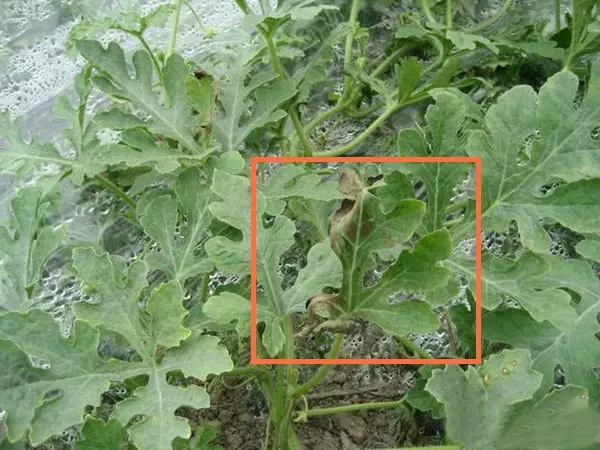
Watermelon wilting occurs during the seedling, vine extension, fruiting, and other growth stages, with the heaviest onset observed during this period.
Initially, the base of the young stem brown constricted, cotyledons, young leaves wilting and drooping, suddenly collapsed. The infected plants growth is slow, the lower leaves yellowing, and gradually upward development. At the beginning of the disease, the plant seedlings dying during the day and recovers in the morning and evening, and after a few days the whole plant dies.
However, as the illness proceeds, afflicted plants grow yellow and finally turn brown. As the fungus invades and the watermelon peperomia host generates tyloses as a defence mechanism, the vascular system of infected plants becomes discoloured. The severity of watermelon fusarium wilt correlates positively with the extent to which the fungus has colonised the vascular system.
Non-dead plants are stunted and produce fewer and smaller fruits. The epidermis at the base of the stem of the wilted plant is rough and the rootstock is longitudinally split. When wet, the stem is water-soaked rot, white to pink moldy material appears, and that is conidia of the disease. The fungal often flows out of the gelatinous material, the vascular tissue of the stem then becomes brown. The roots of diseased plants, part or all of which turn dark brown and rotten, are easily pulled up.
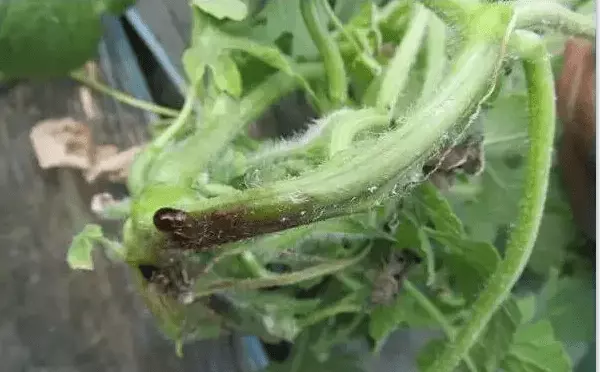
The pathogen Fusarium oxysporum f. sp. Niveum (FON), which has four races (Race 0, 1, 2, and 3) with varying virulence and aggressiveness on watermelon cultivars. Other Fusarium oxysporum f sp formae speciales affect other crops, but are typically not pathogenic to watermelon.
FON is an aggressive fungal that spreads by soil spores. Infected seeds often initiate watermelon wilting, but it can also be transmitted as a soil-borne disease through wind, water, animals, and humans. The pathogen can live in the soil as chlamydospores for extended periods of time. In addition, the pathogen is able to thrive on numerous asymptomatic hosts.
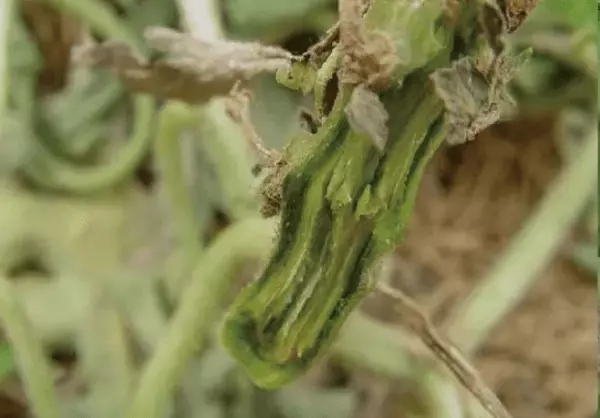
Watermelon plants wilting is a soil-borne disease, its incidence is directly determined by the number of infestable bacteria in the soil. Environmental conditions, variety resistance, seed quality, tillage management are disease factors.
Fusarium oxysporum can survive in the soil for many years, heavy crops can cause a large accumulation. According to our previous survey: the incidence rate is 3.6% in one-year rotation fields, 1.4% in two-year rotation fields, 0.71% in five-year rotation fields, and 12.8% in continuous crop fields.
The stickiness and heaviness of the soil, its low-lying nature, poor drainage, sloppy tillage, low soil temperature, uneven ground, etc., all contribute to unfavorable conditions for the root system and growth and development of melon. Good soil environmental conditions promote root development, thus enhancing watermelon wilt disease resistance. The disease is also heavier with the application of unrotted bacterial fertilizers, partial application of nitrogen fertilizers or chasing chemical fertilizers that injure the roots. Over-grooming of the plants results in more wounds, making the melon seedlings susceptible to infection and premature failure.
When the watermelon fungus survives in the soil, the temperature and humidity are the dominant factors for the development of watermelon fungus. The temperature requirement ranges from 8℃ to 35℃, and 24℃ to 28℃ is the most suitable. If the weather is rainy and sunny, or rain after a long drought, or too much irrigation, irrigation too many times, poor permeability of the melon root system, high temperature and high humidity soil environment, highly susceptible to watermelon fusarium wilt.
Different watermelon varieties have different resistance to blight, and there are differences in the onset between varieties. The degree of wilt occurrence at the seed harvesting site directly affects the number of seeds with bacteria and with bacteria.
Poor physical properties of soil, low organic matter content, uneven land preparation, water logging after rain or irrigation, easy to induce the occurrence of disease. The soil is acidic, which is not conducive to the growth of melon crop roots, but conducive to the germination and spread of wilting infestation.
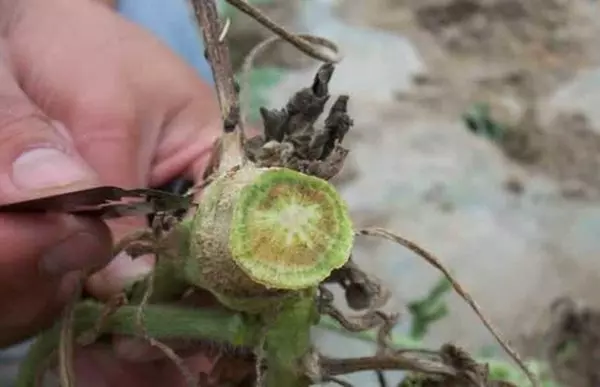
There are several ways to control fusarium wilt watermelon, including using an organic micro-based solution, bacteria, fungi, or chemicals.
Rotation or mixed planting with onion crops, can reduce the number of fungal in the soil of the subsequent crop, to reduce the occurrence of disease. Production, advocate watermelon and corn or sugar cane crop rotation.
Select varieties with strong resistance to fusarium wilt and adversity, wide adaptability, good appearance and internal quality, and high yield.
Focus on substrate disease detection in seedling trays. Choose non-infected areas or seedling enterprises with good reputation and strong technical ability to buy grafted seedlings.
Watermelon wilting has obvious host specialization, watermelon grafting often wild pumpkin as rootstock, in the seedling stage using plugging, splitting and other methods, can effectively reduce the incidence of blight.
The use of drip or micro-sprinkler irrigation water and fertilizer integration can effectively prevent the spread of disease in the field, reduce field farming operations, and can prevent the soil from being too dry and too wet, grafting wound infection, reduce the plant’s wounded roots, unfavorable infestation of the plant roots.
According to the law of fertilizer requirements of different fertility stages of melon for reasonable and balanced fertilization, and supplement the necessary trace elements, so as to ensure that the plant grows robustly to enhance wilt resistance.
Infected watermelon growing regions are not suitable for planting again. Before leaving an infectious location, sanitize garden tools. To effectively destroy contaminated plant matter, you should burn it or dispose of it in plastic bags that you have sealed. Never put contaminated waste in your compost bin.
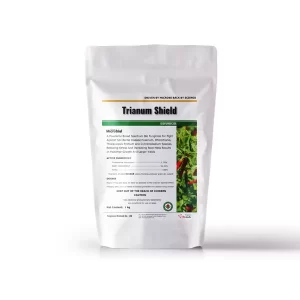 What fungicide kills Fusarium? The common chemical fungicide are Methomyl, Thiram, Iprodione and thiophanate-methyl can play a certain degree of control effect in the early stage. However, the use of chemical fungicides easily causes pesticide residues, which are harmful to humans and animals. Therefore, we do not recommend using them for long-term use in large-scale production as they are not conducive to it.
What fungicide kills Fusarium? The common chemical fungicide are Methomyl, Thiram, Iprodione and thiophanate-methyl can play a certain degree of control effect in the early stage. However, the use of chemical fungicides easily causes pesticide residues, which are harmful to humans and animals. Therefore, we do not recommend using them for long-term use in large-scale production as they are not conducive to it.
Trianum Shield,designed by Tangsons Biotech, is an organic fungicide with trichoderma harzianum formulation for suppression of fusarium wilt in watermelon. After applied at early stage of plantation, it can faster grow and quickly colonize in the rhizosphere and form a biofilm around roots, reducing the damage to plant roots through antagonistic effects such as nutrient competition between microorganisms. Moreover, it will increase the organic matter of soil, promote stronger and healthier roots, increase the uptake of plants and protect the crops loss and potential yields increased.
Start to use Trianum Shield for fusarium wilt watermelon treatment today.
Another biocontrol agent, Bacillus subtilis bacteria competes with the fungus for space and nutrients in the xylem vessels, preventing it from colonizing and causing disease.
Another method of fusarium wilt watermelon treatment is to apply a fungicide to the soil around the base of the plant. Considering chemical control as a last resort, it is recommended to use it for killing any spores of the fungus present in the soil and preventing their infection of the plant. However, it is important to note that these chemical methods can be harmful to both humans and the environment.
Cutworms in gardens are a major menace to all..
As a farmer,I inspect my fields daily to monitor..
It all started with a worried farmer named Mr...

Leave a Reply